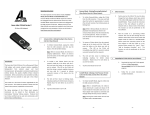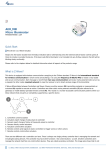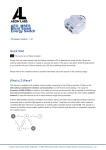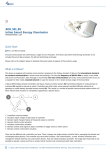Download Aeon Labs Z-Stick
Transcript
Aeon Labs Z-Stick (Z-Wave USB Adapter) Introduction: The Aeon Labs Z-Stick is a self-powered Z-Wave USB adapter with remote network creation capabilities (independent from external power and host microprocessor). By being able to remotely include/remove Z-Wave devices, this greatly simplifies Z-Wave network installation. When connected to a host processor (via USB), it enables the host processor to take part in the Z-Wave Network. By taking advantage of the Z-Wave mesh network, commands can be routed to their destination via intermediary “listening” Z-Wave products. Products that are Z-Wave certified can be used and communicate with other Z-Wave certified devices. Operating instructions: The Z-Stick operates in three distinct modes: Inclusion-Mode, Removal-Mode and SerialAPIMode. Both Inclusion-Mode and Removal-Mode require the Z-Stick to be unplugged from the USB connector of the host, while SerialAPI-Mode requires that the Z-Stick to be plugged into the USB connector of the host. • Inclusion-Mode : Adding/Including Z-Wave Devices into the Z-Wave Network 1. To initiate Inclusion-Mode, unplug the Z-Stick from the USB connector and then tap the button. (The LED will blink slowly.) Note: While in Inclusion-Mode, the Z-Stick is in perpetual add/inclusion. There is no need to press the button on the Z-Stick again to include each new device. 2. To include a new Z-Wave device into the network, simply go to the device with the ZStick and press the button on the device you wish to include. (The LED on the Z-Stick will blink fast during a network neighbor discovery and stay solid for 3 seconds to indicate successful inclusion of the device into the network.) 3. The LED will then return to blinking slowly, indicating readiness for further device inclusions. Repeat step 2 for each device as you wish to include. 4. Tap the Z-Stick button to turn it off. • Removal-Mode : Deleting/Removing/Excluding Z-Wave Devices from the Z-Wave Network 1. To initiate Removal-Mode, unplug the Z-Stick from the USB connector. Then press and hold down the button for approximately 3 seconds. (The LED will transition from blinking slowly to blinking fast.) Note: While in Removal-Mode, the Z-Stick is in perpetual removal/exclusion where it will remove Z-Wave devices from the networks they are currently paired to. There is no need to press the button on the Z-Stick again to exclude each device. 2. To remove a Z-Wave device from the network, simply go to the device with the Z-Stick and press the button on the device you wish to remove. (The LED on the Z-Stick will immediately stay solid for 3 seconds to indicate successful removal from the network.) 3. The LED will then return to blinking fast, indicating readiness for further device exclusions. Repeat step 2 for each device as you wish to exclude. 4. Tap the Z-Stick button to turn off. • SerialAPI-Mode : Allowing a Host Processor To Take Control of the Z-Stick and Take Part in the Z-Wave Network 1. To initiate SerialAPI-Mode, plug the Z-Stick into the USB connector of the host. Note: While in SerialAPI-mode, the Z-Stick is always listening (it is awake and always in RX receive mode) for instructions and acts as a Z-Wave adapter and responds to commands sent through USB by the host processor software. Note: Pressing the Z-Stick button will not have any effect while in SerialAPI-Mode. • Other Functions: • Factory reset on the Z-Stick: This must be done through the host software which takes control of the Z-Stick USB adapter while the Z-Stick is in SerialAPI-Mode. Please consult the instruction manual of the host software to perform a network reset (i.e. factory reset on the Z-Stick). This function can only be preformed via the host software. • Add the Z-Stick to a pre-existing Z-Wave network: This must be done through the host software which takes control of the Z-Stick USB adapter while the Z-Stick is in SerialAPIMode. Please consult the instruction manual of the host software to add the Z-Stick to a pre-existing Z-Wave network (i.e. “Learn”, “Sync”, “Add as Secondary Controller”, etc.). This function can only be preformed via the host software.













